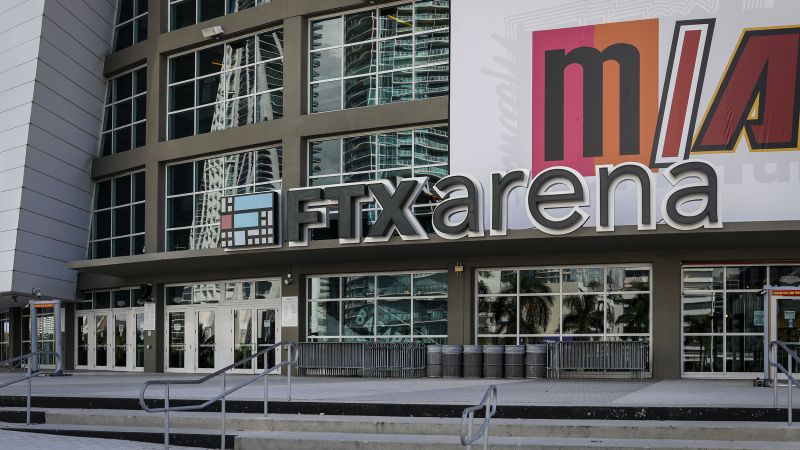Editor’s Note: Jake Cline is a writer and editor in Miami whose work has appeared in The Washington Post, The Atlantic and other national outlets. He was a member of the team that won the 2019 Pulitzer Prize in Public Service for the South Florida Sun Sentinel’s coverage of the mass shooting at Marjory Stoneman Douglas High School. The opinions expressed here are his own. Read more opinion on CNN.
CNN
—
Thanks in large part to bitcoin evangelism by top officials in Miami, the city has spent the past couple of years in full-blown cryptomania.
In the vision of Mayor Francis Suarez – the city’s chief cheerleader for digital currency – Miami will one day become the national capital for cryptocurrency.

Two years ago, Miami published its “Bitcoin White Paper” – a blueprint for its transformation into a 21st century city. Around the same time, prominent crypto figures began relocating to the city, and Miami began hawking its own digital currency, MiamiCoin.
As the fever quickened, cryptocurrency exchanges began advertising on Miami billboards. Bitcoin ATMs were installed at neighborhood gas stations and convenience stores.
And perhaps the most visible symbol allowing Miami to flex its crypto bragging rights was the announcement in March of 2021 by Miami-Dade County that it had sold naming rights for its main sports arena – home of the beloved Miami Heat NBA franchise – to FTX, the now bankrupt cryptocurrency exchange founded by disgraced crypto entrepreneur Sam Bankman-Fried.
That partnership, which is not even two years old, came to an unhappy end last week. On Wednesday, the beleaguered company and Miami’s local government finalized an agreement to terminate the deal and remove the now tarnished FTX logo from the sports venue.
Over the past few months, as the scale of Bankman-Fried’s alleged fraud became clear, some city elders and the business community scrambled to unwind what many of us had suspected from the start was a simply terrible business deal. Bankman-Fried, who has maintained his innocence, pleaded not guilty to federal fraud charges during a court appearance in New York earlier this month.
We now know just what a fiasco Miami’s love affair with crypto has been. The financial costs of last year’s crypto crash have been enormous for the many thousands of investors who invested – and then lost funds they could ill afford to forgo.
But my own reservations were not rooted in certain knowledge that crypto would crumble, although its collapse was far swifter and more spectacular than even most skeptics anticipated.
My opposition to crypto is based on its deleterious effects on the environment. The fact that Miami, considered “the most vulnerable major coastal city in the world,” would go all in for a currency created by a climate-wrecking technology always seemed to me to be a particular kind of madness.
Many people don’t understand how a currency that exists largely in the digital space can have real-life destructive impacts on our environment. Bitcoin mining uses vast amounts of resources. As the New Yorker’s Elizabeth Kolbert wrote in an April 2021 article, “bitcoin-mining operations worldwide now use … about the annual electricity consumption of the entire nation of Sweden.”
Citing data scientist Alex de Vries’ Digiconomist website, Kolbert reported that “a single bitcoin transaction uses the same amount of power that the average American household consumes in a month.” Similar reporting could be found at The New York Times, The Washington Post and CNN.
Bitcoin mining hardware has ramped up as the cryptocurrency’s popularity has increased. Between January 1, 2016, and June 30, 2018, the mining operations for four major cryptocurrencies released an estimated three to 15 million metric tons of carbon dioxide, according to a study in the research journal Nature Sustainability.
Even China, the world’s largest polluter, banned bitcoin mining in 2021, citing its high carbon emissions. Now we are in what has been called “crypto winter” after enthusiasm has plummeted for cryptocurrencies worldwide. Nevertheless, the carbon footprint of bitcoin, still the world’s most valuable digital currency, continues to be enormous.
This past September, a report from the White House Office of Science and Technology Policy found that crypto mining in the United States emits as much greenhouse gas as the nation’s railroads and cautioned that “depending on the energy intensity of the technology used, crypto-assets could hinder broader efforts to achieve net-zero carbon pollution consistent with U.S. climate commitments and goals.”
But despite all that data, Suarez remains convinced that it’s possible to produce bitcoin in an environmentally friendly way.
“I’d love to sort of dispel some of the, I think, myths — I call them myths — of [crypto] mining as a not-environmentally-friendly activity,” the mayor said during his Crypto Conference, a live-streamed event held in June 2021.
And because there are renewable-energy sources in South Florida, his argument goes, crypto miners could eventually be incentivized to stop contributing to the destruction of our planet. He has argued, in effect, that because renewable energy sources exist, miners might just in the future opt to use them. It’s an extraordinarily weak argument. It would be a wonderful outcome, if only we could interest bitcoin miners in abandoning their pursuit of cheap and dirty energy sources.
But he’s not wrong – it is entirely possible to mine bitcoin responsibly, as bitcoin’s leading competitor, ethereum, proved last year. A decentralized global network used for verifying billions of dollars of cryptocurrency transactions, ethereum in September completed a system-wide transformation known as the Merge.
Essentially, ethereum moved to a mining process, known as proof of stake, that requires significantly less computing power than bitcoiners’ preferred process, proof of work. In doing so, ethereum appears to have reduced its worldwide energy consumption by more than 99%.
While some bitcoin miners say they want their industry to go green, the majority resist calls to adopt the proof of stake system over fears it would eat into their profits. Meanwhile, residents of Miami seem torn on environmental matters. According to a survey conducted by Yale University, as well as George Mason University, they believe that local officials, and state officials, including the governor “should do more to address global warming.”
But Miami voters helped to propel a “red wave” that installed Republican supermajorities in both chambers of the Florida legislature — a body that under GOP control allows fossil-fuel companies to write its bills.
Residents of Miami-Dade County this past November also voted to reelect Gov. Ron DeSantis, who has said that while he doesn’t consider himself a “climate change denier” he hopes never to be mistaken for a “climate change believer.”
And despite everything that has happened with the digital currency’s plummeting value, Suarez, who is also president of the United States Conference of Mayors, remains a bitcoin believer.
Miami-Dade County will once again play host later this year to Bitcoin 2023, the next installment of the annual conference. And Suarez told a Miami TV station that he continues to receive his government salary in bitcoin, as he has since November 2021.
Some dreams, it would seem, die hard.
Note:- (Not all news on the site expresses the point of view of the site, but we transmit this news automatically and translate it through programmatic technology on the site and not from a human editor. The content is auto-generated from a syndicated feed.))



